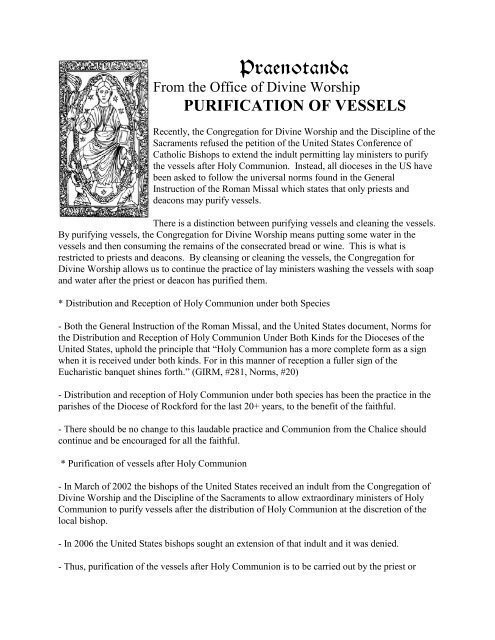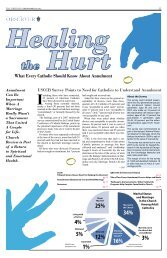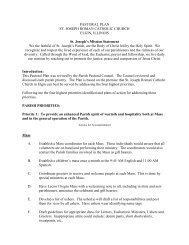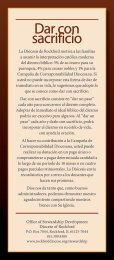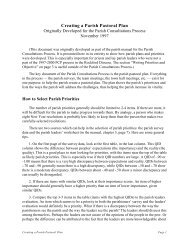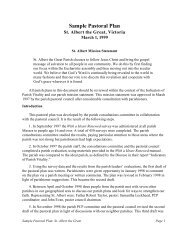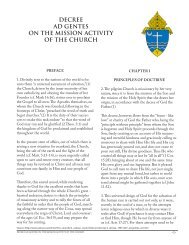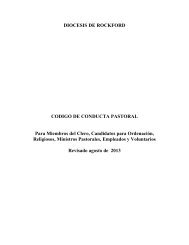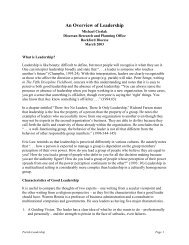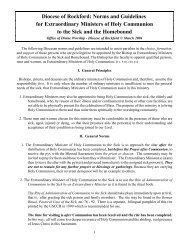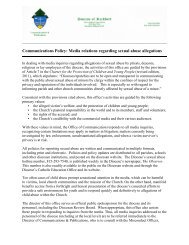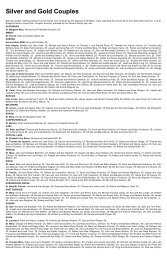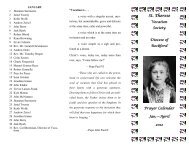Praenotanda - Diocese of Rockford
Praenotanda - Diocese of Rockford
Praenotanda - Diocese of Rockford
Create successful ePaper yourself
Turn your PDF publications into a flip-book with our unique Google optimized e-Paper software.
<strong>Praenotanda</strong><br />
From the Office <strong>of</strong> Divine Worship<br />
PURIFICATION OF VESSELS<br />
Recently, the Congregation for Divine Worship and the Discipline <strong>of</strong> the<br />
Sacraments refused the petition <strong>of</strong> the United States Conference <strong>of</strong><br />
Catholic Bishops to extend the indult permitting lay ministers to purify<br />
the vessels after Holy Communion. Instead, all dioceses in the US have<br />
been asked to follow the universal norms found in the General<br />
Instruction <strong>of</strong> the Roman Missal which states that only priests and<br />
deacons may purify vessels.<br />
There is a distinction between purifying vessels and cleaning the vessels.<br />
By purifying vessels, the Congregation for Divine Worship means putting some water in the<br />
vessels and then consuming the remains <strong>of</strong> the consecrated bread or wine. This is what is<br />
restricted to priests and deacons. By cleansing or cleaning the vessels, the Congregation for<br />
Divine Worship allows us to continue the practice <strong>of</strong> lay ministers washing the vessels with soap<br />
and water after the priest or deacon has purified them.<br />
* Distribution and Reception <strong>of</strong> Holy Communion under both Species<br />
- Both the General Instruction <strong>of</strong> the Roman Missal, and the United States document, Norms for<br />
the Distribution and Reception <strong>of</strong> Holy Communion Under Both Kinds for the <strong>Diocese</strong>s <strong>of</strong> the<br />
United States, uphold the principle that “Holy Communion has a more complete form as a sign<br />
when it is received under both kinds. For in this manner <strong>of</strong> reception a fuller sign <strong>of</strong> the<br />
Eucharistic banquet shines forth.” (GIRM, #281, Norms, #20)<br />
- Distribution and reception <strong>of</strong> Holy Communion under both species has been the practice in the<br />
parishes <strong>of</strong> the <strong>Diocese</strong> <strong>of</strong> <strong>Rockford</strong> for the last 20+ years, to the benefit <strong>of</strong> the faithful.<br />
- There should be no change to this laudable practice and Communion from the Chalice should<br />
continue and be encouraged for all the faithful.<br />
* Purification <strong>of</strong> vessels after Holy Communion<br />
- In March <strong>of</strong> 2002 the bishops <strong>of</strong> the United States received an indult from the Congregation <strong>of</strong><br />
Divine Worship and the Discipline <strong>of</strong> the Sacraments to allow extraordinary ministers <strong>of</strong> Holy<br />
Communion to purify vessels after the distribution <strong>of</strong> Holy Communion at the discretion <strong>of</strong> the<br />
local bishop.<br />
- In 2006 the United States bishops sought an extension <strong>of</strong> that indult and it was denied.<br />
- Thus, purification <strong>of</strong> the vessels after Holy Communion is to be carried out by the priest or
deacon, or in the absence <strong>of</strong> a deacon, by an instituted acolyte (GIRM, #182, 192).<br />
* Options to consider in the purification <strong>of</strong> vessels after Holy Communion<br />
In General<br />
- Bishop Doran has extended permission to Extraordinary Ministers <strong>of</strong> Holy Communion to<br />
consume what remains <strong>of</strong> the Precious Blood from their chalice <strong>of</strong> distribution, at that time<br />
purification is to be left to the Deacon, Instituted Acolyte, or Priest.<br />
- For a large number <strong>of</strong> Communion vessels, it is permissible to wait until after Mass has ended,<br />
rather than to purify them at the altar or the credence table during Mass (cf. GIRM, #183).<br />
- In this case, the vessels are set on the credence table, suitably covered with an appropriately<br />
clean cloth. After Mass, they may be taken to the sacristy where they are purified by either the<br />
deacon or the priest after he has greeted the people. After they have been purified they can be<br />
washed by the sacristan or other minister as usual.<br />
- As part <strong>of</strong> the ongoing formation <strong>of</strong> extraordinary ministers <strong>of</strong> Holy Communion and sacristans,<br />
these directives should be made known and explained to them at an opportune time prior to<br />
December 3.<br />
In Parishes and Institutions where there is a deacon(s) assigned<br />
- At Masses where a deacon is scheduled, it is most appropriate that, after Mass, he should purify<br />
the vessels before they are washed as usual.<br />
In Parishes and Institutions where there is no deacon assigned<br />
- The chalices and other Communion vessels may be taken to the sacristy after the completion <strong>of</strong><br />
the celebration <strong>of</strong> Mass.<br />
- If there is a large number <strong>of</strong> chalices to be purified, or if time constraints warrant it, the priest<br />
may purify by pouring water into the first chalice, swirling the water around in the customary<br />
manner, and then pouring it into the next chalice, and then into the next, etc. After he has done so<br />
with the last chalice to be purified, he consumes the ablution. The vessels may then be washed by<br />
the sacristan or other minister as usual.<br />
- The priest celebrant may be assisted by other priests <strong>of</strong> the parish in the purification <strong>of</strong> the<br />
sacred vessels after Mass.


